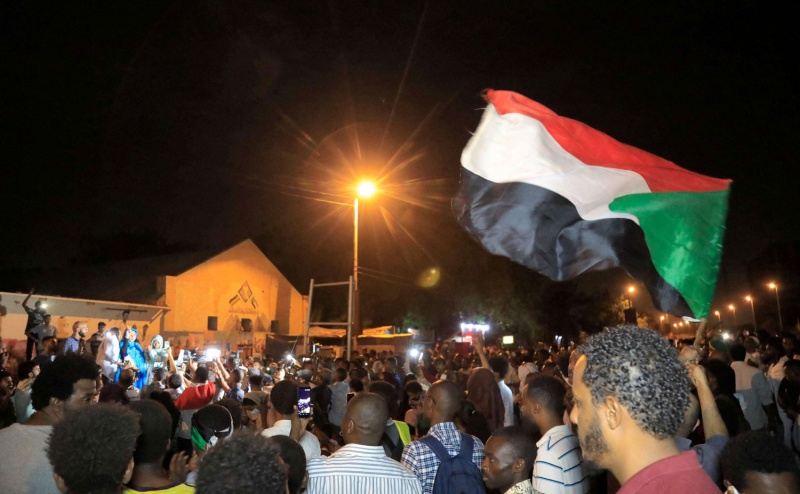Armed forces used excessive and lethal force against peaceful protesters gathered in Khartoum on May 11, 2021, to commemorate victims of a 2019 deadly crackdown, Human Rights Watch said today. Sudan’s Ministry of Health said two people were killed and thirty-seven injured.
Sudan’s repression of peaceful protests underscores the need for its international partners to scrutinize the authorities’ commitment to reforming the security forces and ensuring meaningful justice.
“Sudan’s army blocked, opened fire on, and beat people commemorating lives lost fighting for justice,” said Laetita Bader, Horn of Africa director at Human Rights Watch. “Once again in the new Sudan, security forces are resorting to abusive old tactics.”
On May 11, an association of families of protesters killed during the country’s 2018-19 revolution, which ended Omar al-Bashir’s 30-year-rule, and other groups organized an iftar(breaking of the fast). The event commemorated the second anniversary of the government crackdown on protestors on June 3, 2019, and the following days in which security forces killed at least 120 people and injured hundreds around Khartoum. The transitional government intiated an investigation into those events in September 2019, but victims’ families and other protest groups say that the investigation has been slow and question its independence.
Human Rights Watch interviewed nine witnesses by telephone, including journalists and activists, who took part in the commemorations and witnessed the military’s heavy-handed response.
On May 10, the Sudan Armed Forces (SAF) issued statement saying they would block all main roads leading to their headquarters on the day of the iftar. Between 4 p.m. and 5 p.m. on May 11, protesters gathered outside SAF headquarters in central Khartoum, notably along Nile street and near the University of Khartoum campus. One protester said that as the crowd grew, they decided to march forward and break the lines of soldiers and cement blocks set up by the army to reach the location planned for the iftar.
“The army had set up cement blocks and deployed a number of soldiers, including military police and a couple of armored vehicles,” the protester said. “After some shoving between protesters and soldiers, they ]soldiers[moved away and let protesters hold their iftar.”
After the iftar ceremony, held near a famous vocational training center on Nile street, speakers from various protest groups took to the center’s stage. Several people said the number of soldiers started to increase, forming “cordons” around the crowd, which later hindered their dispersal. The witnesses saw some soldiers position themselves at a tunnel, which passed near the stage and above the tunnel on railway tracks that pass over it, allowing for only a narrow exit from the vocational training center to Nile street.
“I could see from where I was standing near the main stage that SAF soldiers were moving and forming what looked like a box,” said the father of a protester killed in 2019. “I saw army soldiers moving to split the crowd into two.”
A journalist said that when the last person was speaking, soldiers started to move closer to the crowd, almost encircling them: “I saw soldiers pushing protesters away from the tunnel area and toward the stage. The soldiers, many armed, also positioned themselves at the railway bridge above the tunnel.”
Three witnesses said they saw high-ranking army officers, including brigadiers and colonels, identified by their insignia, alongside the soldiers who were deployed around the area.
About 8 p.m., the final speaker asked the audience to disperse. The large number of soldiers, including military police, made it hard for the protesters to leave through the only exit the soldiers had left available. An event organizer said that he and others approached a group of soldiers and asked them to create space for people to disperse. “They [protesters] can walk over and crush each other,” a soldier replied. “We do not care. We just want you out of here.”
Soldiers, apparently unprovoked and without warning, started to beat protesters. One witness said he saw soldiers spreading out along the exit toward Nile street, chasing protesters, and saw some soldiers beating protesters with gun butts. “The soldiers were very aggressive, they were just beating everyone and for no reason,” he said. “There was no provocation at all. I saw some female protesters beaten by the soldiers and falling down to the ground.”
Another witness who was on Nile street said: “I saw this guy beaten by three soldiers. He was on the ground and bleeding from his head, but the soldiers kept beating him with sticks, fists, gun butts and kicking him.”
as.-Witnesses said they then heard gunshots. Five witnesses said they first heard them coming from the direction of the railway tracks and saw soldiers there pointing their guns directly at the protesters who tried to flee. One protester said: “I ran toward Nile street. There I saw soldiers coming from different directions. I saw one soldier with his Kalashnikov [assault rifle] shooting indiscriminately. He was holding the gun at a direct level toward people, not in the air. He was shooting like he did not care where it ]the bullet[would hit.”
Some protesters started to throw rocks and stones at the soldiers.
“There were around three soldiers in uniform and one person in civilian clothing,” said a 24-year-old student who was among a group shouting at soldiers on Nile street close to the University of Khartoum campus. “They were shooting in the air, sometimes on the ground, and we could see the flare on the asphalt, they kept shooting. One of the soldiers at that time was kneeling, directing his gun toward us when he pulled the trigger. Suddenly I felt someone near me fall down. I looked back and it was Mudathir on the ground bleeding from his chest. I and others immediately picked him up. He was already dead when we reached him, but we still put him on a motorbike and took him to the hospital.”
Official records show that the military’s violent dispersal killed two young men: Osman Ahmed Badr al-Din, andMudathir Mokhtar al-Shafi. Sudan’s attorney general, who has since resigned , Taj al-Sir al-Hibr, said that the forensic report found that the two were shot: “in case of Osman, the bullet damaged the heart and lungs…he was shot in the back…and for Mudathir, it damaged the heart and liver.”He said that this may indicate that the shooting was “intentional.”








